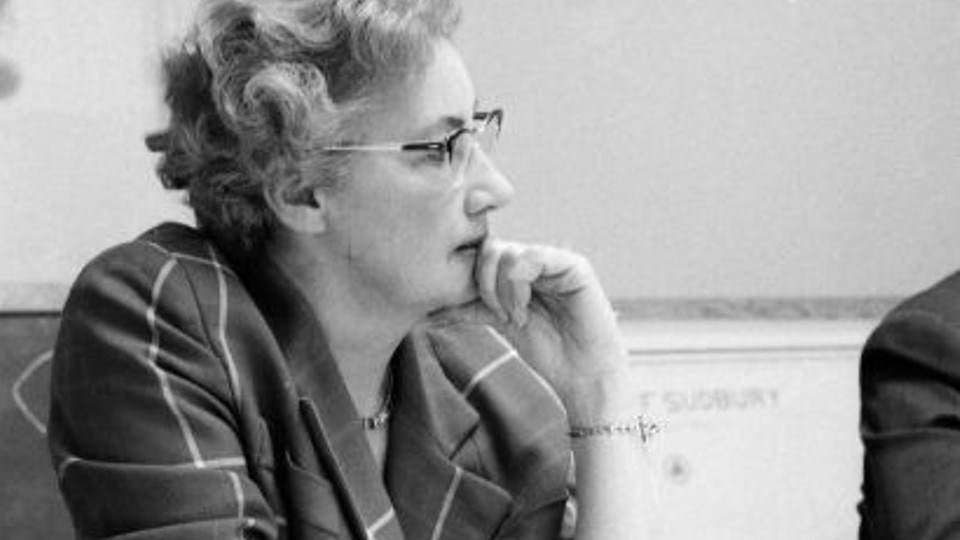March is Women's History Month, a good opportunity to remember trailblazers such as the City of Sudbury's only female mayor, Grace Hartman, who paved the way for other women in local politics.
Hartman was mayor for one year after she was appointed by council to replace Mayor Max Silverman when he died in office in 1966.
Was Sudbury ready for a woman mayor? When Hartman, who had 17 years’ experience in municipal politics, ran for mayor in the following election in the fall of 1967, she was defeated by Joe Fabbro. (Fabbro also defeated Hartman in 1956 when she first ran for mayor.)
There would not be another woman mayor for 45 years when Marianne Matichuk was elected mayor of the amalgamated City of Greater Sudbury in 2010.
Even Diane Marleau, who ran in 1985 against incumbent Peter Wong — she entered federal politics in 1988 and held prominent cabinet posts in Jean Chrétien's government — could overcome civic machismo.
Hartman was born at the beginning of the 20th century and died in 1998. She was a witness to massive changes in Canadian society. Women were not allowed to vote in Ontario provincial elections or stand for political office until 1917. In May 1918, white women, over the age of 21, got the federal vote. A year later, women were allowed to run for a seat in the House of Commons. The first woman to be elected mayor in Canadian history was Barbara McCallum Hanley, mayor of Webbwood, Ont., from 1936 to 1944.
A leader among her peers
Grace Armstrong Hartman was born in 1900 in Markdale, a small town south of Owen Sound, which was named for her great uncle, Mark Armstrong. An unusually pretty girl, she was athletic and established herself as a leader among her peers.
She studied at Victoria College at the University of Toronto. After graduation, she taught English, French, Latin, art, and physical education at the high school level.
During a two-year break, she travelled throughout Europe and Japan while taking teaching assignments at private schools.
Hartman married late for a woman of her generation. In 1938, she wed George Hartman, a superintendent of power plants for the International Nickel Company at High Falls, and the couple moved to Sudbury.
In her adopted city, she became a founding member of the Sudbury branch of the Canadian Federation of University Women (CFUW) and its first president. She was also the first president of the Women’s Voluntary Services of Sudbury. The women set up a canteen near the downtown railway station to feed servicemen during the Second World War.
In 1945, Hartman was appointed the first woman member of the Sudbury High School Board, a position she held for five years. In 1950, at the urging of the Sudbury Business and Professional Women’s Club (BPW), she ran for city council. Hartman and Dr. Faustina Kelly Cook, both elected in December 1950, were Sudbury's first women aldermen. (In the late 1980s. Northern Life editor Carol Mulligan shamed council to adopt the gender-neutral name "councillor.")
In 1954, Hartman was elected to the board of control and in the 1960s became deputy mayor. As a city leader, she championed the building of the Greek-like open air concert centre in an extension of Bell Park as a Centennial project, and as mayor in 1967, she attended its opening.
Members of BPW (Sudbury) and CFUW (Sudbury) lobbied to have the amphitheatre named in her honour in 2001. In 2010, the original structure, poorly maintained by the city, was torn out of the park and replaced with a modern stage and seating.
Hartman Street, near the Sudbury courthouse, is also named in her honour.
Hartman had boundless energy for good causes. She served as president of the Ontario Municipal Association in 1960 and held leadership roles with the Sudbury YWCA, Sudbury IODE (Nipissing chapter), Sudbury United Church Women’s Association, Sudbury Progressive Conservative Women’s Association and the Sudbury Airport Commission.
She was a member of the Sudbury Public Library board, and volunteered with the District Home for the Aged board, BPW (Sudbury), Beta Sigma Phi Sorority and the Royal Ontario Museum.
Widowed in 1960, she married Arthur Grout, a prominent businessman from Chapleau in 1968. They retired to Toronto and enjoyed travelling. The couple spent winters in Florida and summers in Chapleau.
Hartman remained close to her friends and colleagues in Sudbury. In 1973, she gave an investment certificate to BPW (Sudbury) to provide financial assistance to women entering politics for the first time.
During Ontario’s International Women’s Year celebrations in 1975, Hartman was named one of the 25 leading women of Ontario.
In the last years of her life, Hartman married a third time. She became blind, but remained independent travelling alone from Toronto to Sudbury in June 1982 to receive an honorary doctorate of laws from Laurentian University.
Marianne Matichuk, elected for one term in 2010, is the City of Greater Sudbury's first female mayor. Since amalgamation in 2000, four women have run unsuccessfully for mayor: Mary Fournier Pagnutti (2000); Louise Portelance (2003 ) Lynne Reynolds (2006) and Patricia Mills (2018).
Vicki Gilhula is a freelance writer. She is a former editor of Northern Life and Sudbury Living magazine, and has a special interest in local history. Then and Now is made possible by our Community Leaders Program.
Sources: Section15.ca: Social activist and mayor Grace Hartman by Mary Lue Hunds, Jan. 30, 2002.
Special thanks to Shanna Fraser, archivist for the City of Greater Sudbury.
